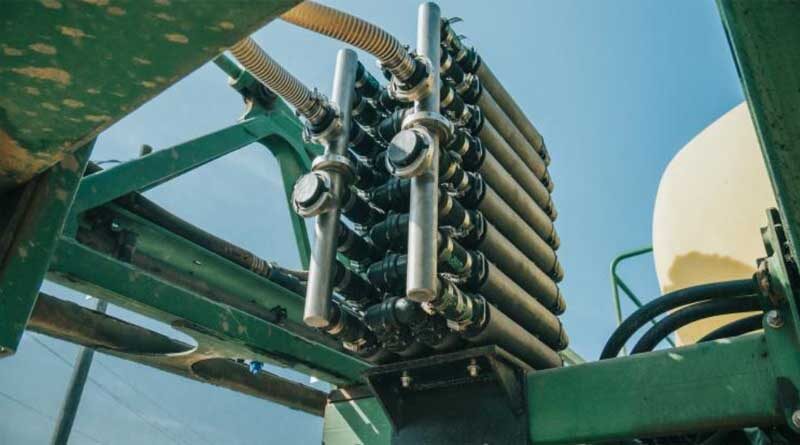MagGrow earns award, expands reach in U.S.
Innovative startup uses high-power magnets to reduce spray drift and improve crop protection product performance.
19 October 2021, US: MagGrow wants your sprayer to gain a “magnetic” personality. The Irish startup is using new technology to enhance sprayer precision and reduce drift — with a range of university and independent tests proving its success.
The startup was recently recognized by Bayer and SVG Ventures-Thrive as the winner of the Sustainable Scaleup Award for its “technology that helps farmers reduce waste and drift linked to conventional crop spraying, delivering optimal plant protection using permanent rare earth magnets.”
The award will allow the company to explore a pilot project with Bayer, receive automatic nomination for Thrive’s Top 50 listing, and gain access to Bayer resources and Thrive’s ecosystem. The goal of the project is to help identify solutions to reduce the environmental impact of crop protection products.
While the collaboration with Bayer is welcomed, MagGrow has already proven its magnets get the job done in extensive, multiyear testing, both in the lab and the field. The challenge the company has is getting customers in the U.S. market to buy into using the technology, as well as demonstrating how material flowing from sprayer through the boom and nozzle will reduce drift and boost material-to-plant contact.
“There’s a lot of wacky science out there, or little science; it’s all over the place and not proven,” says Gary Wickham, CEO and co-founder of MagGrow. “We saw this big problem that up to 70% of crop protection product was waste during application, and we saw that sometimes farmers didn’t even know they had the problem.”
Wickham, a scientist by training, saw electrostatic sprayers that charge the product before application creating the positive-negative attraction to boost chemical-to-plant contact. Wickham found that these permanent, rare earth magnets, at the right power, could make a difference. For five years, the company used a science-based approach to develop the product, which has been on the market for two years. The company is looking to expand in the U.S.
“We’re using existing science in a different way, and the core science is out there,” he says.
To overcome the skeptics, MagGrow has partnered with universities in Europe and the U.S. to show the product at work.
“We didn’t launch the product directly into the market; we spent five years developing the technology,” he says. Working with physicist Mike Coey and his team at Trinity College in Dublin, the company engaged in research and development. Coey is internationally known for his work in magnetic treatment of fluids.
Wickham notes Coey has written an 800-page book covering mathematical formulas surrounding his work in magnetism and the treatment of fluids. “It’s really complex,” Wickham notes. “I sent the book to my salespeople, and one said, ‘Why are you sending that? We can’t understand this.’“
The key is that the technology is easy to use, but the science is extremely complex.
Magnets in the field
For Jerry Brightbill, raising cotton near Plainview, Texas, means managing a lot of factors, including crop protection spraying. Two decades ago, he invested in two electrostatic sprayers to improve coverage and reduce drift, and was happy with the result. But the complexity of the sprayers and their upkeep became a problem.
Brightbill is also a Trimble dealer, and in 2020, Trimble and MagGrow entered into a marketing agreement for the product. That’s when he heard about using the strong magnets on a sprayer to cut drift and improve contact and performance.
Brightbill ran a test in the fall of 2020. With two Case IH sprayers, he ran one and his son the other. On one, he installed the MagGrow system, which includes a high-power magnetic manifold on the sprayer, with strong magnets all along the boom.
He tested the system for applying harvest aids on cotton. Using a full rate, the conventional sprayer made a strip through the field. Then the MagGrow-equipped sprayer made passes at a rate of 100%, 75% and 50%. A second application was done within two weeks.
A few days after the second application, Brightbill’s consultant found that the 50% application had the same impact on the crop as the 100% application with the MagGrow sprayer. However, the conventional sprayer still had some green leaves, which is a challenge when stripping time arrives.
For 2021, Brightbill cut his rate for use of Liberty on his cotton to 75% using the MagGrow-equipped sprayer and saw consistent weed control. His area is plagued by Palmer pigweed and kochia.
“If you can get the chemical to the plant, you can kill the weed,” he says. “This system makes sense because it ‘charges’ the chemical to make better contact with the plant.”
Using powerful magnets to change the fluid as it moves through the sprayer is showing it can reduce drift and improve plant contact in a range of case studies being conducted at the university level. Is it right for your sprayer? You can learn more at maggrow.com.















